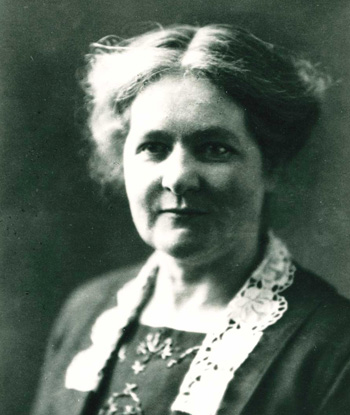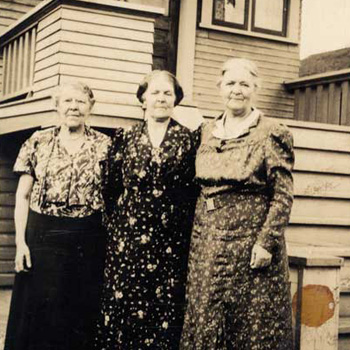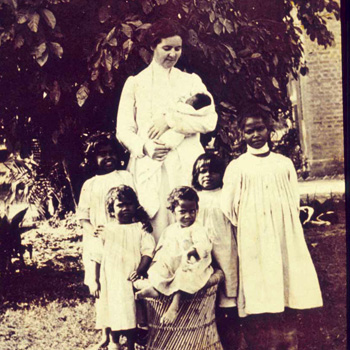From the .
There was nothing medical missionary Dr. Jemima MacKenzie (MD 1904, LLD’40) wouldn’t do when it came to helping the poor and sick of India. She prevented an outbreak of cholera after inoculating people night and day. She learned how to do cataract surgery by correspondence. She adopted dozens of abandoned children.
And once, Dr. MacKenzie, the daughter of a Pictou County farmer, detonated dynamite that she brought from home to blast a well and supply a rural community with safe drinking water.
 Resourceful, determined, gutsy. These words seem like understatements when it comes to describing Jemima MacKenzie, who graduated from Dalhousie Medical School at the turn of the last century.
Resourceful, determined, gutsy. These words seem like understatements when it comes to describing Jemima MacKenzie, who graduated from Dalhousie Medical School at the turn of the last century.
Her missionary zeal was ignited as a 10-year-old – her head filled with stories of injustice and hardship in faraway India – at Sunday School in Little Caribou River Church, Pictou County, N.S. “She told us she heard about women and children dying unnecessarily because of lack of education and poor hygiene and because the women were too ashamed to be seen by male doctors,” relates her daughter Sarina Bayer from her home in Mississauga, Ont. “She told us that is when she made her vow. When she grew up, she would become a doctor. She would work to help the women in India.”
In 1882, when young Mina, as she was called, made her resolution, there were a few things impeding her. First, she was female, and at the time, Dalhousie Medical School had yet to admit a woman for the study of medicine. Second, she was poor – one of 14 children growing up on a farm in Pictou County. And third, as the youngest daughter, she was expected to care for her parents as they got older.
In the end, all three obstacles created detours for Mina, but they didn’t deter her from her calling. When she died at the age of 84 in Pictou, she had spent more than three decades in India. For her selfless service, she earned India’s highest honour, the Kaisar-i-Hind Medal for Public Service from the Viceroy of India, and an honorary degree from Dalhousie.
Jemima (Mina) MacKenzie was born August 18, 1872, the youngest of Simon and Ann MacKenzie’s children. The large Scots Presbyterian family lived on a struggling farm in Waterside, Pictou County, not far from where the Wood Islands Ferry wharf is located today.
When Mina was in school, not yet having passed Grade 11, she was teaching more than 100 students and commuting among three schools in Pictou, Scotch Hill and Saltsprings. Her mother was ill at the time, so she returned home each weekend. Mina’s life remained like this until her brother Simon and sister-in-law Libby came to live on the home farm, allowing her to complete Grade 12. She was 26 years old.
 Mina and her sister Molly, older than Mina by six years, entered Dalhousie Medical School in Halifax together. Before them, only a handful of women had been admitted to the school and most of those, like the MacKenzie sisters, went on to do missionary work.
Mina and her sister Molly, older than Mina by six years, entered Dalhousie Medical School in Halifax together. Before them, only a handful of women had been admitted to the school and most of those, like the MacKenzie sisters, went on to do missionary work.
Even though the male domain had been breached a few years previous, not all agreed it was a good idea. “To think of disclosing the human form divine, over which humanity bids us to throw a veil of decency, or having the most sacred of feminine mysteries freely discussed before a mixed class of young men and young women is not only shocking, but disgusting and degrading,” huffed an editorial writer in a Kingston, Ont., newspaper at the time Mina and Molly were bending their heads over their books.
“The women who studied medicine had to be forceful,” says Dr. Jock Murray, a former dean of Dalhousie Medical School who is writing a history of the med school with his wife, Janet. “They had to stand up to the men in their class. They had to stand up to society.”
Mina graduated in 1904, accepting her diploma in a borrowed academic gown. Her graduation photo shows a young woman with a stern expression, her dark hair piled high on her head, Gibson Girl-style, and wearing a lacy, shirtwaist blouse with a high collar. Her mother was well enough to attend the ceremony, but fell ill and died soon afterwards.
Her dream on hold for so long, Dr. MacKenzie didn’t delay leaving Nova Scotia after her mother’s death. Molly still had another year of school to go before she could graduate, so Mina went to Boston to earn the $200 needed for Molly’s tuition. Then, with an appointment by the Women’s Union Missionary Society of America, she set off for India.
On arrival in northeast India, Mina was the sole doctor in a rural area. She had a dog, Laddie, and outfitted a small medical cart for him to pull so she could take her clinic on the road. ¬Ý
‚ÄúDr. Mina performed her first operation on a dressing table,‚Äù writes her niece Ruth Munro in Dr. Mina MacKenzie: Her Life and Work in India.¬Ý ‚ÄúThere was no one to give the chloroform, no one to hand her instruments and the helper kept fainting. Yet, she was able to cope, with pilipili¬˛ª≠.‚Äù
Once Molly joined her, the sisters moved on to Fatehpur, where they established a hospital still in operation today. Molly and Mina worked side by side for six years, dispensing equal doses of medical care and prayer. Molly returned to Canada, where she married and became a minister’s wife. She continued to work in medicine as a medical inspector of rural schools in Ontario.
Mina was called home by her elderly father in 1920, who begged her to attend him “for the rest of my days,” as quoted by Ruth Munro in her book. Back in Pictou County, Mina never stopped: she led Sunday school in the kitchen and opened a private hospital in the parlour. Her brother Simon built the operating table and set it by the screen door for natural light. She held church picnics and raised money for the first of many orphans she adopted in India. In all, she adopted 44 children, some of them baby girls unwanted by their families and abandoned by the side of the Ganges River.
 After her father‚Äôs funeral in 1922, Mina returned to India, this time bringing with her the financial support and heartfelt wishes of the people of Pictou County. And something else: a cache of nitro-glycerine that her brother Simon carefully set amongst her clothing in her¬Ý trunk.
After her father‚Äôs funeral in 1922, Mina returned to India, this time bringing with her the financial support and heartfelt wishes of the people of Pictou County. And something else: a cache of nitro-glycerine that her brother Simon carefully set amongst her clothing in her¬Ý trunk.
Her great nephew Ian Munro, 71, picks up the story: “Simon was a farmer who used explosives for clearing the land. She told him about the problem of the water supply and how it got polluted during the rainy season. He agreed a well was the answer, but ‘good Lord, Mina you’ll blow your damn head off!’ So he showed her how to do it and packed up the dynamite ... The first charge scared the hell outta the local people, some of them tore off into the jungle when the rocks went flying. But she got her well. She put her mind to it and she got it.”
Ian, a retired teacher from Liverpool, N.S., traveled to India last year to see the places where his great aunt worked almost a century earlier. He shakes his head in wonder at the things she was able to accomplish. “When I was a kid, I thought she was a nice old lady who prayed a lot. I had no idea.”
Her life continues to inspire. Her daughter Sarina established a foundation in Mina’s name that has funded the education of more than 100 children. She remembers her mother as kind and loving, but strict. She was a large woman, over six feet tall, and she spoke with a pronounced Scottish accent. “She took time for us, even though she was so busy and often tired. At night, after her rounds at the hospital, she would kiss us and tuck us under our malaria nets.”
Like many of the girls Mina adopted, Mrs. Bayer became a nurse. She came to Canada in 1957 to care for her mother in her retirement. But just weeks after the reunion, Mina died at the age of 84.
“Her legacy is that we must care for one another,” she says. “Just like when we were little and the older sisters would look after the younger ones.”
Read about other inspiring Dal grads at .

